Chemical burns can cause irreparable harm to human health. Therefore, it is very important to be able to provide first aid to the victim. In most cases, the degree of damage and the consequences of the burn will depend on this, in most cases.
Content
- Chemical skin burn: features, symptoms, diagnosis
- The degree of chemical burns
- Chemical burns treatment rules
- First aid for chemical burn
- Treatment of chemical burns
- Chemical burn of the eye
- Chemical burn of the oral cavity or esophagus
- Chemical Facial burn
- Chemical burn, photo
- Video: "First aid for chemical burn"
It is important to understand the significant difference between chemical and thermal burns. With burns, chemical reagents need to clearly know the substances of antidotes that neutralize the effects of one or another chemical reagent. What to do with a chemical burn? How to treat a chemical burn? Is it possible to cope with the treatment of a chemical burn at home? About everything in order - in this selection of material.

Chemical skin burn: features, symptoms, diagnosis
Chemical burn is a violation of the integrity of the tissues of the human body under the influence of agents of a chemical nature.

This type of burn becomes more dangerous than the thermal burn. This is due to the type of aggressively acting chemical and the duration of the reagent. The process of destruction of cells and absorption of a chemical can continue even after eliminating the chemical component, which often complicates the timely determination of the degree of damage.
Chemical burns arise due to non -compliance with safety rules when working with chemical reagents or in case of accidents in everyday life (intentionally or by negligence).
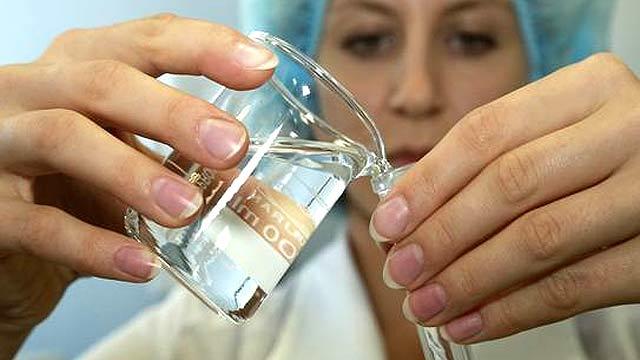
External symptoms of chemical burns are different depending on the action of the chemical substance. Most often, acid or alkaline drugs become a source of damage.
- When exposed to the skin of alkali , the resulting scab is more loose, with blurry boundaries. Alkaline fluids can penetrate deeper into the skin than acids, causing more large -scale damage to soft tissues.
- When exposed to acid skin , A dense, dry crust (scab) with clear contours is formed at the site of the lesion.
Burns caused by the effects of chemical acids in most cases are superficial. By the color of the injured skin, you can determine the name of the acting acid.
- Under contact with sulfuric acid, the skin becomes white at first, then looks. With prolonged contact, the burn acquires a darker, brown tint.
- Impact on the skin nitric acid leads to a change in the skin to yellow-green or brown-yellow color (depending on the duration of the contact).
- After exposure hydrochloric acid , The skin is noticeably yellow.
- The burn caused acetic acid, becomes dark brown.
- Carbon acid causes a white area of \u200b\u200bdamaged skin, which over time changes to brown.
The degree of damage can be diagnosed as accurately as possible only after a few days (when the suppuration of the scabs begins). The longer the effect of chemical components on the tissues of the body and the larger area of \u200b\u200bdamage, the more dangerous the burn for human health and life. Therefore, with chemical burns, it is very important to provide first aid to the victim, and then immediately consult a qualified medical care.
It is in the hospital by the nature of the available damage, the depth of penetration, the concentration of the chemical reagent and the duration of its effect that the degree of the resulting chemical burn will be established and treatment is prescribed.
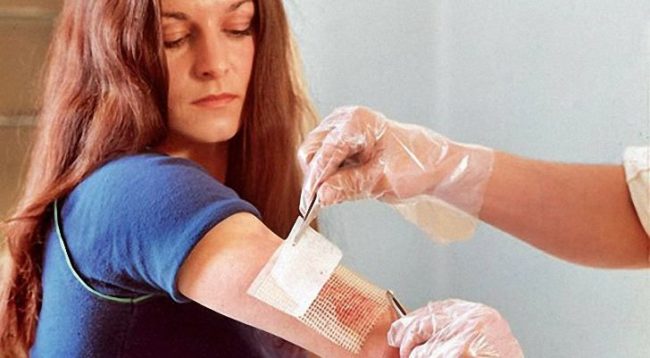
No less dangerous is the general toxic poisoning of the body with an aggressive chemical component. Therefore, it is sometimes difficult to diagnose damaged skin, all the negative effect of the reagent on the human body and possible consequences.
In addition to skin damage, eyes or internal organs, in particular the gastrointestinal tract, can suffer from a chemical burn. Pits of the body with thin skin (face, skin folds, genitals area) are more affected, since the thickness of the epidermis is the smallest.

The degree of chemical burns
There are 4 main degrees of chemical burns.
- Idegree
Only the upper layer of the skin is affected, there is a small edema and redness of the site. The burn is accompanied by moderate painful sensations, treatment is carried out at home.
- IIdegree
In the second degree of burn, not only the upper layer of the skin, but also the lower fabrics are damaged. The burn is accompanied by swelling, redness and the appearance of bubbles with a transparent serous fluid. The level of pain and sensitivity becomes higher than at the first degree, but with a small area of \u200b\u200bburn, the patient does not need hospitalization.
- III degree
There is a deep defeat and murder of tissues, up to fatty subcutaneous tissue. In a damaged place, small bubbles with muddy liquid appear, sometimes with blood. The sensitivity of the skin is significantly reduced and the patient practically does not feel pain in the place of burn. The victim needs hospitalization, since spontaneous healing of the wound is often impossible.
- IVdegree
The most dangerous degree in which not only skin, muscle tissue, but also tendons, bones are deeply affected. Surgical care is provided in the hospital.
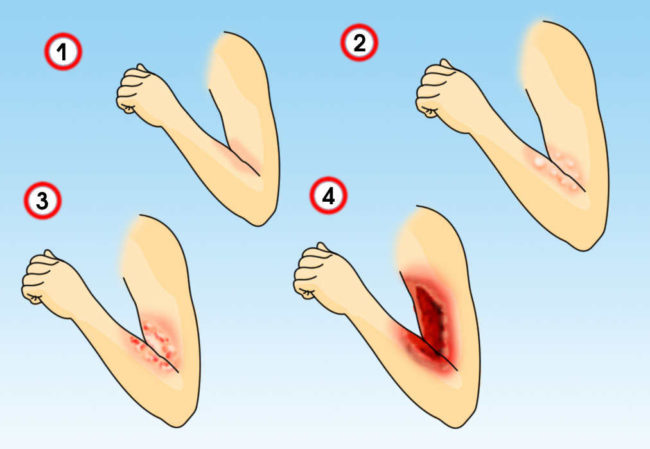
Chemical burns treatment rules
There are a number of rules, the application of which in emergency situations will help to significantly alleviate the condition of the victim and reduce the effect of the reagent on the body.
- First aid for chemical burns should be provided without delay and fuss. You need to act calmly and judiciously. How high -quality and correctly the first aid is provided to the victim, the success of further treatment will depend.
- It is especially important to know the rules for the provision of first aid to people working with chemicals. Indeed, in such situations, there are much more risks to get a chemical trauma.
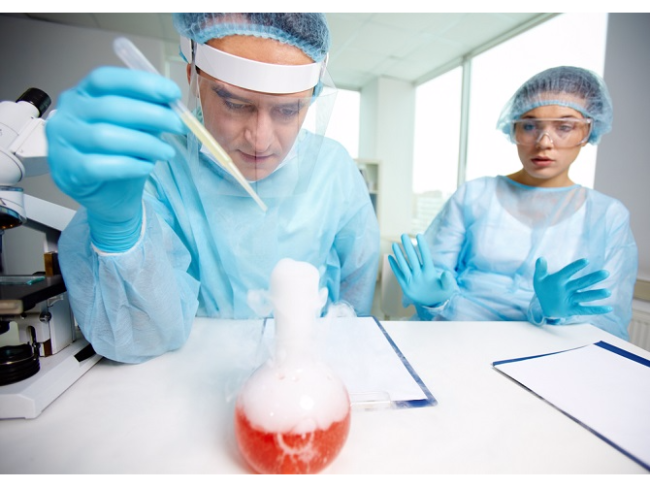
- Knowledge of the main antidotes below will help to neutralize the actual substance faster.
- After receiving first aid, the patient must consult a doctor in order to exclude possible negative consequences after a burn.
- The main rule for first aid is not to harm the victim.
- Key rules for the treatment of chemical burns, except for the provision of qualified first aid to the victim, are reduced to drying the wound, treating antiseptics (so that there is no suppuration) and the use of drugs that improve blood circulation and tissue regeneration processes.
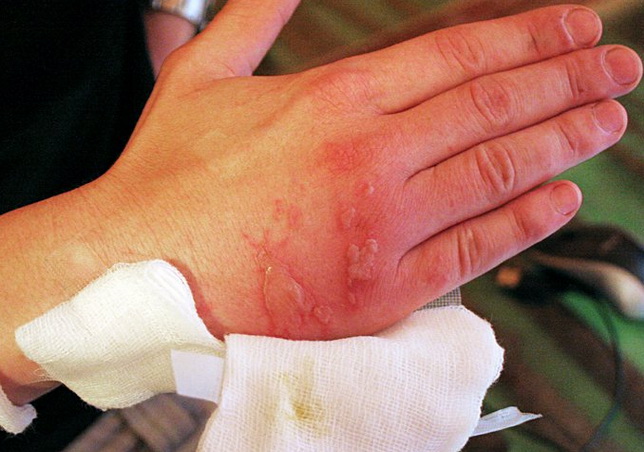
First aid for chemical burn
The first medical care for chemical burns is able to radically change the subsequent treatment process, both for the best and worse. Therefore, before assisting the victim, you need to be 100% confident in your knowledge, so as not to harm the victim.
- First of all, with a chemical burn, it is important to stop the action of a chemical agent. Therefore, if the substance hit the clothes, it must be immediately removed or cut.
- If the remains of powder chemicals remain on the skin - they are first shaken off the skin and only then washed off the remains.
- The damaged area of \u200b\u200bthe skin is thoroughly washed with running water, thereby reducing the concentration of the chemical, the depth of its penetration, cooling the skin and reducing pain. Rinse the wound for 10 - 30 minutes.
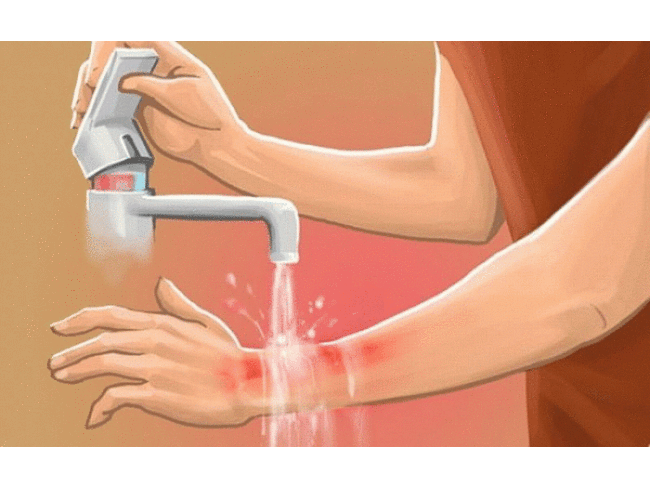
The exception is burns caused by alkali, negative lime, aluminum -organic compounds!
- If the burn is caused by acid, affected area of \u200b\u200bthe skin rinse with a 1-2% solution of sodathen put a swab moistened in solution of ammonia (alcohol is diluted with water). You can not “repay” a burn with a solution of alkali - this will lead to a new burn, only caused by the alkali. The action of diluted acid is more dangerous than concentrated. This is due to the fact that high -concentrated acid instantly causes protein coagulation, forming a dense scab, preventing the deepening of the burn. Especially dangerous is the exposure to the skin of high toxic coat, used, for example, for glass etching.
- A burn caused by alkali Dangerous with its rapid penetration deep into the fabrics. Such a burn you can’t wash it immediately with water. The hydroxyl group of alkali under the influence of water will contribute to a deeper penetration of the chemical into human tissues. The affected area of \u200b\u200bthe skin washed with a 1-2% solution of acetic or citric acid with a 1-2% (not concentrated).
- Burned in an open lime Also you can not treat with water, since gashneen lime (strong base) is formed during the interaction. In this situation, it is better to lubricate the place of burn with fat and consult a doctor.
- A burn caused by pesticides and herbicidesProcess ethyl alcohol or gasoline. After the first aid, the victim should be taken to the hospital for the administration of the antidida drug.
- A section of a burn caused by phosphorus, completely immerse into the water to prevent spontaneous combustion of the reagent. After that, removing the phosphorus particles available on the skin, apply a bandage moistened in a weak solution potassium permanganate.
- Phenolic burn Neutralized by solution alcohol or vodka.
- After washing and neutralization of the chemical reagent, the burns should be applied to the place a sterile dry bandage.
Vatu for a bandage cannot be used!
- With strong pain, the patient can be given analgesic drug.
- Before the arrival of an ambulance, the victim needs to drink as much liquid as possible (for example, tea or mineral water).
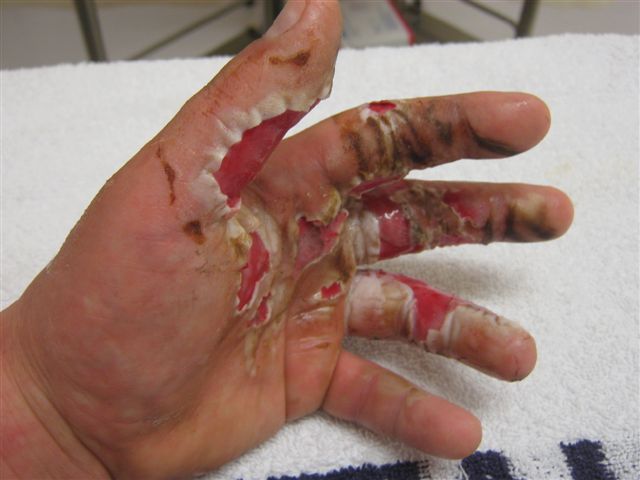
Treatment of chemical burns
- The main rule for the treatment of chemical burns, including at home, is to carry out the use of drugs only after consulting and examining a doctor. For safety reasons and a positive effect, you should not self -medicate, risking health and life.
- For the treatment of chemical skin burns, it is recommended to lubricate the affected area with special medicinal ointments (Fuziderm, Solcoseryl). Burns caused by chemicals need the subsequent regeneration of cells and blood supply, to which the action of the above ointments is directed.
- Excellent restorative, disinfecting, healing and drying effects also have such drugsLike Bepanten, Panthenol, ichthyol ointment, sea buckthorn oil.
- Blessing iodine or silver They have an antiseptic, disinfectant, drying and analgesic effect.
- There are also folk recipescontributing to the healing of wounds after thermal and chemical burns. These include compresses based on medicinal herbs: chamomile, oak bark, hop cones. Having prepared decoctions from these herbs, take a sterile bandage, moisten and applied to the wound for 15 minutes. You can prepare a therapeutic ointment based on aloe leaves. To do this, take 2-3 sheets of aloe, wash them, cut off the spikes and grind them into the "gruel". Melted fat is added to this mass (pork or guts); After cooling - the ointment is ready for use. The use of folk recipes is still better to discuss with the attending physician.
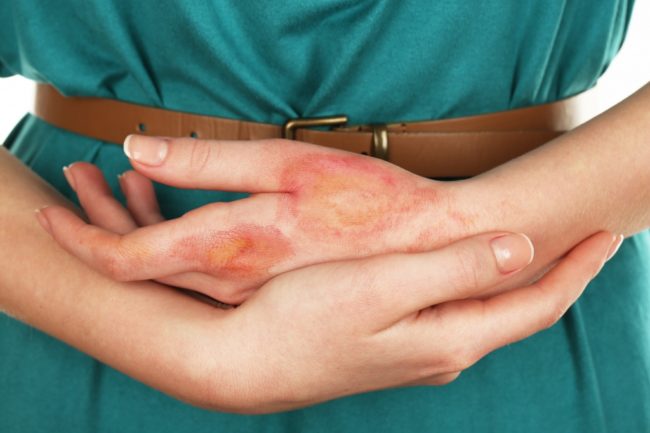
Ximic burn eyes
The chemical burn of the eye is one of the most complex aspects in terms of treatment in ophthalmology. The danger of such burns lies in a possible weakening or complete loss of vision. This directly depends on the degree of defeat, depth of penetration and, directly, the type of chemical reagent.
- In practice, the chemical burn of the eye with acid is considered less complicated than the ingress of an alkaline solution. This is due to the fact that acids provoke instant coagulation of proteins and, therefore, not a deep penetration of the reagent. The exception is nitrogen, sulfur, smelter. In the event of alkali, the reagent destroys the cells and can lead to tissue necrosis.
- The provision of first aid for chemical burns of the eye comes down to abundant washing of the eye and ambulance. At home, it is impossible to provide qualified assistance with such lesions.
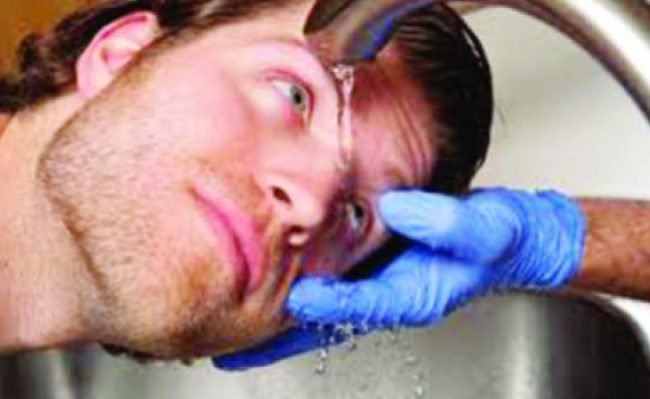

Ximic burn of the oral cavity or esophagus
- This type of burns is one of the most difficult in treatment and restoration.
- In such situations, it is impossible to provide first aid by neutralizing a chemical agent. Only if we are talking about the chemical burn of the oral cavity, you can try to rinse the mucous membrane of the oral cavity with water before the arrival of the ambulance (if it is allowed by the type of acting chemical).
- The main task of providing first aid for burns of the digestive system is to urgently call an ambulance.
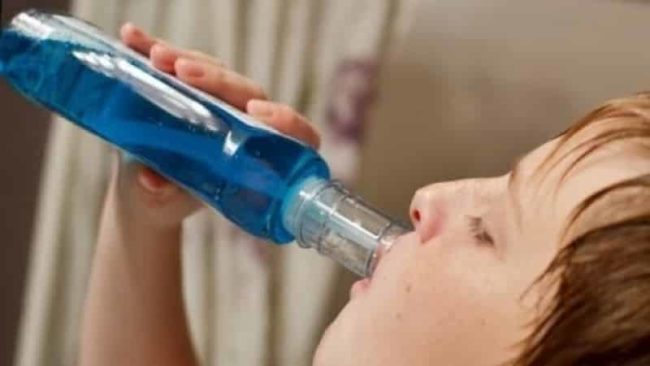
Ximic burning of the face
- The skin of the face is thin and sensitive, and with strong chemical burns, a chemical reagent can disrupt the regenerative function of the skin cells, which leads to the formation of cicatricial tissue. From an aesthetic point of view, such “traces” on the face disfigure the appearance of a person, give rise to psychological problems. From a medical point of view, gross scars disrupt the motor and excretory function of the skin.
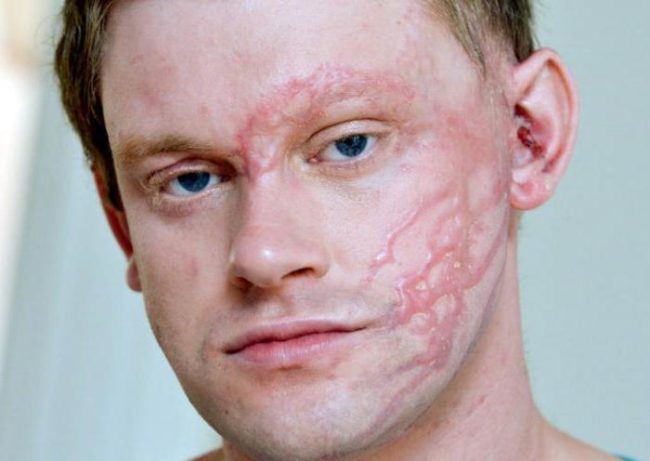
- Nowadays, such a cosmetic procedure as peeling fruit acids has become popular. With improper dosage and concentration of acidic solution, a shallow chemical burn of the 1st degree is also possible. Such a cosmetic burn often requires the subsequent rather long course of treatment.
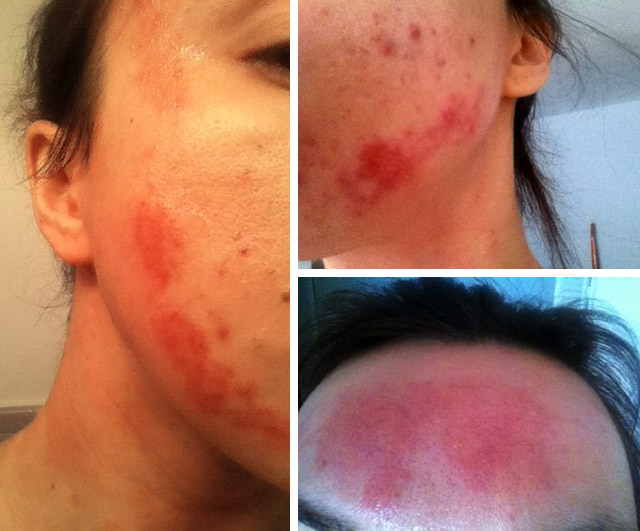
Thus, chemical burns are a serious danger to human health and life, which means they need qualified medical treatment. But, having information about the features of different types of burns and their treatment, one can provide first aid to the victim in time. Correct and timely actions before the arrival of ambulance can significantly alleviate the patient's condition and contribute to his speedy recovery.
Chemical burn, photo
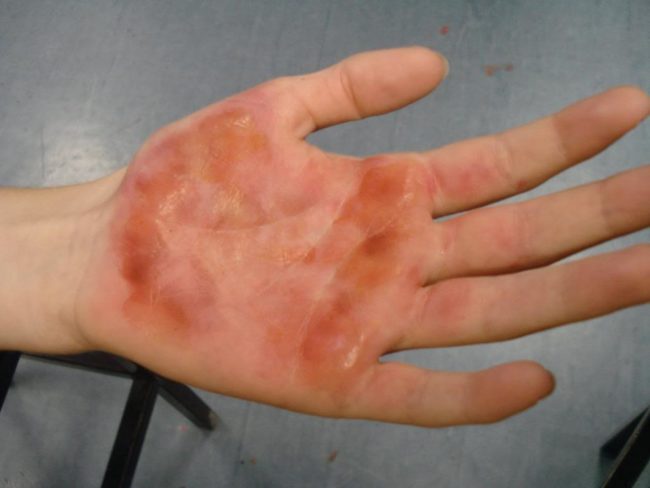
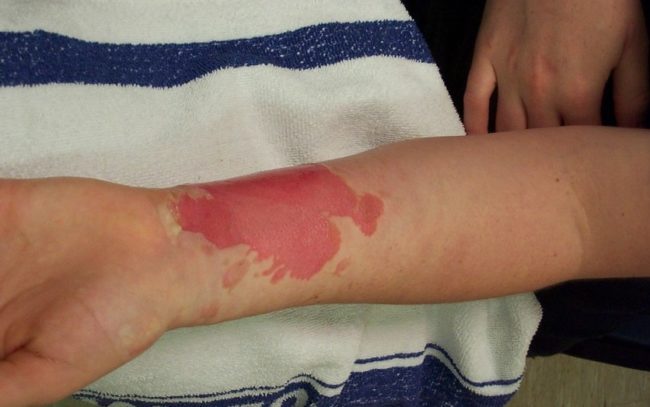
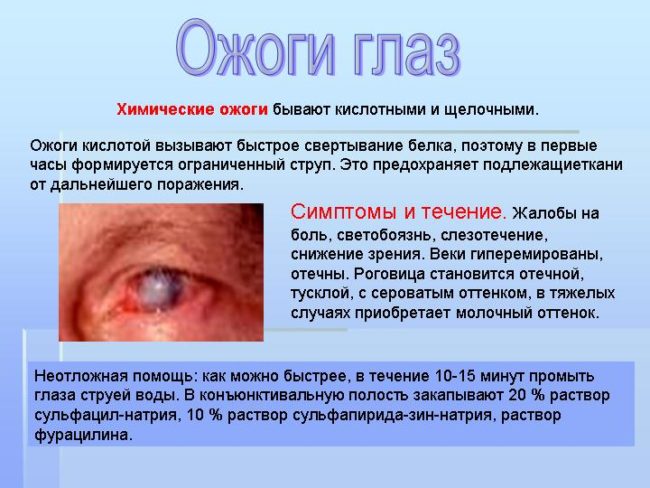
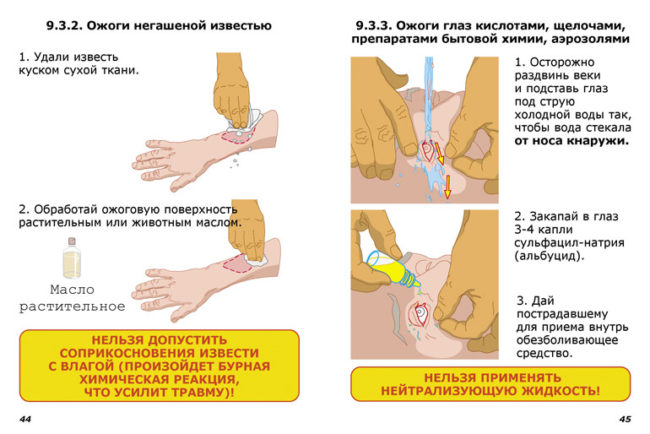









Comments
a couple of years ago, there was no side of metrogils from the same problem, there were no side effects ...
I’m not a fan of peeling at all, it saves from acne of metrogil, it also smoothes it ...
Great article! ...
I take the second course of the Capsules Climafite 911. The tides went very quickly. It became calmer, irritability went away and I sleep well ...
i also noticed - it is worth nervous, everything immediately affects the face. Therefore, I try to avoid conflicts and unpleasant people. Of the creams, I like Miaflow from wrinkles - smoothes not only small wrinkles ...